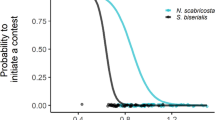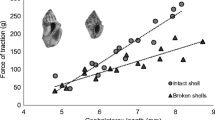Abstract
Resources may confer advantages by enhancing their owners’ fighting ability (resource holding potential; RHP). While the resource-correlated RHP hypothesis has been recognized as a determinant of agonistic success in different taxa, this has mostly been based on assessment of either the intruder or the owner, but only rarely in both contestants. We tested whether the internal structure of shells affects hermit crabs’ RHP, both as owners defending the shell against eviction and as intruders attempting to gain access to an occupied shell. We conducted contests (n = 60) to compare the success in shell eviction by intruders in intact shells vs. in shells with the columella artificially reduced, and the success of shell retention by owners in intact shells vs. shells with the columella reduced. The internal configuration of the shell showed different resource-correlated RHP effects depending on the individual’s role in the fight. The presence of a columella in the intruder’s shell did not affect the likelihood that they would evict their opponents. However, owners resisted more evictions in shells with intact columella than those in shells with reduced columella. Our results demonstrate that the same resource can offer different RHP advantages to owners and intruders during an agonistic interaction.




Similar content being viewed by others
References
Alcaraz, G. & K. N. García-Cabello, 2017. Feeding and metabolic compensations in response to different foraging costs. Hydrobiologia 787: 217–227.
Alcaraz, G. & G. I. Jofre, 2017. Aggressiveness compensates for low muscle strength and metabolic disadvantages in shell fighting: an outcome of the individual’s past. Behavioral Ecology and Sociobiology 71: 1–11.
Alcaraz, G., C. E. Chávez-Solís & K. Kruesi, 2015. Mismatch between body growth and shell preference in hermit crabs is explained by protection from predators. Hydrobiologia 743: 151–156.
Alcaraz, G., B. Toledo & L. Burciaga, 2020. The energetic costs of living in the surf and impacts on zonation of shells occupied by hermit crabs. The Journal of Experimental Biology 223: 1–11.
Arce, E. & G. Alcaraz, 2011. Shell use by the hermit crab Calcinus californiensis at different levels of the intertidal zone. Scientia Marina 75: 121–128.
Arce, E. & G. Alcaraz, 2012. Shell preference in a hermit crab: comparison between a matrix of paired comparisons and a multiple-alternative experiment. Marine Biology 159: 853–862.
Arce, E. & G. Alcaraz, 2013. Plasticity of shell preference and its antipredatory advantages in the hermit crab Calcinus californiensis. Canadian Journal of Zoology 91: 321–327.
Arnott, G. & R. W. Elwood, 2007. Fighting for shells: how private information about resource value changes hermit crab pre-fight displays and escalated fight behaviour. Proceedings of the Royal Society B: Biological Sciences 274: 3011–3017.
Arnott, G. & R. W. Elwood, 2008. Information gathering and decision making about resource value in animal contests. Animal Behaviour 76: 529–542.
Arnott, G. & R. W. Elwood, 2009. Assessment of fighting ability in animal contests. Animal Behaviour 77: 991–1004.
Bertness, M. D., 1980. Shell preference and utilization patterns in littoral hermit crabs of the bay of Panama. Journal of Experimental Marine Biology and Ecology 48: 1–16.
Bertness, M. D., 1981. The influence of shell-type on hermit crab growth rate and clutch size (Decapoda, Anomura). Crustaceana 40: 197–205.
Blackstone, N. W., 1985. The effects of shell size and shape on growth and form in the hermit crab Pagurus longicarpus. The Biological Bulletin 168: 75–90.
Briffa, M., 2013. Contests in crustaceans: assessments, decisions and their underlying mechanisms. In Hardy, I. C. & M. Briffa (eds), Animal Contests. Cambridge University Press, Cambridge: 86–112.
Briffa, M. & R. W. Elwood, 2000. Analysis of the finescale timing of repeated signals: does shell rapping in hermit crabs signal stamina? Animal Behaviour 59: 159–165.
Briffa, M. & R. W. Elwood, 2002. Power of shell-rapping signals influences physiological costs and subsequent decisions during hermit crab fights. Proceedings of the Royal Society B: Biological Sciences 269: 2331–2336.
Burciaga, L.M., 2017. Toma de decisiones y resolución del combate en el cangrejo ermitaño Calcinus californiensis. PhD thesis. Universidad Nacional Autónoma de México.
Chapin, K. J., P. E. C. Peixoto & M. Briffa, 2019. Further mismeasures of animal contests: a new framework for assessment strategies. Behavioral Ecology 30: 1177–1185.
Chapman, M. G., 1995. Spatial patterns of shell shape of three species of co-existing littorinid snails in new south wales, Australia. Journal of Experimental Marine Biology and Ecology 61: 141–162.
Chapple, W. D., 1969. Postural control of shell position by the abdomen of the hermit crab, Pagurus pollicarus. III. Analysis of movements and calculations of forces exerted by the muscles. Journal of Experimental Zoology 171: 417–424.
Chapple, W. D., 1973. Role of the abdomen in the regulation of shell position in the hermit crab Pagurus pollicarus. Journal of Comparative Physiology 82: 317–332.
Chapple, W. D., 1993. Dynamics of reflex cocontraction in hermit crab abdomen: experiments and a systems model. Journal of Neurophysiology 69: 1904–1917.
Chapple, W. D., 2012. Kinematics of walking in the hermit crab, Pagurus pollicarus. Arthropod Structure and Development 41: 119–131.
Conover, M. R., 1978. The importance of various shell characteristics to the shell-selection behavior of hermit crabs. Journal of Experimental Marine Biology and Ecology 32: 131–142.
Dowds, B. M. & R. W. Elwood, 1983. Shell wars: assessment strategies and the timing of decisions in hermit crab shell fights. Behaviour 85: 1–24.
Ekstrøm, C. T. & H. Sørensen, 2015. Statistical Data Analysis for the Life Sciences. CRC Press, London.
Elwood, R. W., N. Marks & J. T. A. Dick, 1995. Consequences of shell-species preferences for female reproductive success in the hermit crab Pagurus bernhardus. Marine Biology 123: 431–434.
Enquist, M. & O. Leimar, 1987. Evolution of fighting behaviour: the effect of variation in resource value. Journal of Theoretical Biology 127: 187–205.
Fayed, S. A., M. D. Jennions & P. R. Y. Backwell, 2008. What factors contribute to an ownership advantage? Biology Letters 4: 143–145.
Figler, M. H., G. S. Blank & H. V. S. Peeke, 2005. Shelter competition between resident male red swamp crayfish Procambarus clarkii (Girard) and conspecific intruders varying by sex and reproductive status. Marine and Freshwater Behaviour and Physiology Taylor & Francis 38: 237–248.
Funakoshi, S., 2005. Intraspecific and interspecific competition for larval nests of the caddisflies Stenopsyche marmorata and Stenopsyche sauteri. Entomological Science 8: 339–345.
Gherardi, F., 2006. Fighting behavior in hermit crabs: the combined effect of resource-holding potential and resource value in Pagurus longicarpus. Behavioral Ecology and Sociobiology 59: 500–510.
Hurd, P. L., 2006. Resource holding potential, subjective resource value, and game theoretical models of aggressiveness signalling. Journal of Theoretical Biology 241: 639–648.
Kemp, D. J. & C. Wiklund, 2001. Fighting without weaponry: a review of male-male contest competition in butterflies. Behavioral Ecology and Sociobiology 49: 429–442.
Koolhaas, J. M., C. M. Coppens, S. F. de Boer, B. Buwalda, P. Meerlo & P. J. A. Timmermans, 2013. The resident-intruder paradigm: a standardized test for aggression, violence and social stress. Journal of Visualized Experiments 77:
Krans, J. L. & W. D. Chapple, 2005. Variability of motoneuron activation and the modulation of force production in a postural reflex of the hermit crab abdomen. Journal of Comparative Physiology A: Neuroethology, Sensory, Neural, and Behavioral Physiology 191: 761–775.
Leimar, O. & M. Enquist, 1984. Effects of asymmetries in owner-intruder conflicts. Journal of Theoretical Biology 111: 475–491.
Lindström, K. & C. Pampoulie, 2005. Effects of resource holding potential and resource value on tenure at nest sites in sand gobies. Behavioral Ecology 16: 70–74.
Maynard Smith, J. & G. A. Parker, 1976. The logic of asymmetric contests. Animal Behaviour 24: 159–175.
Parker, G. A., 1974. Assessment strategy and the evolution of fighting behaviour. Journal of Theoretical Biology 47: 223–243.
Pechenik, J. A. & S. Lewis, 2000. Avoidance of drilled gastropod shells by the hermit crab Pagurus longicarpus at Nahant, Massachusetts. Journal of Experimental Marine Biology and Ecology 253: 17–32.
Pechenik, J. A., J. Hsieh, S. Owara, P. Wong, D. Marshall, S. Untersee & W. Li, 2001. Factors selecting for avoidance of drilled shells by the hermit crab Pagurus longicarpus. Journal of Experimental Marine Biology and Ecology 262: 75–89.
Ponder, W. F. & D. R. Lindberg, 1997. Towards a phylogeny of gastropod molluscs: an analysis using morphological characters. Zoological Journal of the Linnean Society 119: 83–265.
Signor, P. W. I. & W. K. Pieter, 1984. Functional significance of columellar folds in turritelliform gastropods. Journal of Paleontology 58: 210–216.
Stutt, A. & P. Willmer, 1998. Territorial defence in speckled wood butterflies: do the hottest males always win? Animal Behaviour 55: 1341–1347.
Suárez-Rodríguez, M., K. Kruesi & G. Alcaraz, 2019. The shadow of the shell: a cue for a new home. Journal of the Marine Biological Association of the United Kingdom 99: 1–5.
Takahashi, M., N. Suzuki & T. Koga, 2001. Burrow defense behaviors in a sand-bubbler crab, Scopimera globosa, in relation to body size and prior residence. Journal of Ethology 19: 93–96.
Taylor, P. W. & R. W. Elwood, 2003. The mismeasure of animal contests. Animal Behaviour 65: 1195–1202.
R Core Team, 2020. R Core Team. A language and environment for statistical computing. R Foundation for Statistical Computing.
Vermeij, G. J., 1978. Biogeography and adaptation: patterns of marine life. Harvard University Press, Cambridge.
Yoshino, K. & S. Goshima, 2001. Functional roles of gastropod shells in the hermit crab Pagurus filholi: effects of shell size and species on fitness. Benthos Research 56: 87–93.
Zuur, A. F., E. N. Ieno, N. J. Walker, A. A. Saveliev & G. M. Smith, 2009. Mixed Effects Models and Extensions in Ecology with R. Springer, New York.
Acknowledgements
We thank the Posgrado en Ciencias del Mar y Limnología, UNAM and the Consejo Nacional de Ciencia y Tecnología (CONACyT) for scholarship no. 709365 and the Programa de Apoyo a Proyectos de Investigación e Innovación Tecnológica, PAPIIT IN-216418, IN-218321. We specially thank Dr. Renato Peña who provided the facilities at the Unidad Piloto de Maricultivos (UPIMA) to perform the experiments, Lili Pelayo and Armando Martinez for their technical support in the field, Dr. Maite Mascaró, Dr. Javier Alcocer, Dr. Carlos Rosas, Dr. Karla Kruesi, and Dr. Patricia Briones for reviewing this article and Dr. Lynna Kiere for English editing.
Author information
Authors and Affiliations
Corresponding author
Additional information
Handling editor: Iacopo Bertocci
Publisher's Note
Springer Nature remains neutral with regard to jurisdictional claims in published maps and institutional affiliations.
Rights and permissions
About this article
Cite this article
Burciaga, L.M., Alvarez, A. & Alcaraz, G. Same resource, different benefits: hermit crab shell structure advantages owners, but not intruders in agonistic interactions. Hydrobiologia 848, 2539–2550 (2021). https://doi.org/10.1007/s10750-021-04573-2
Received:
Revised:
Accepted:
Published:
Issue Date:
DOI: https://doi.org/10.1007/s10750-021-04573-2




